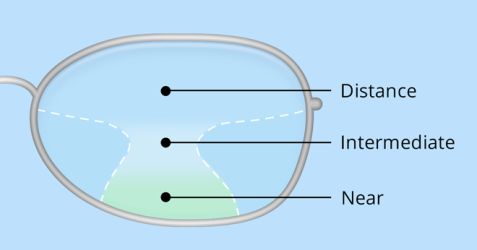Progressive lenses for vision over 40

No one likes to advertise their age — especially 40-something adults who are having trouble reading fine print.
Thankfully, today's progressive lenses make it impossible for others to tell you've reached "bifocal age."
Progressive lenses — sometimes called "no-line bifocals" — give you a more youthful appearance by eliminating the visible lines found in bifocal (and trifocal) lenses. Premium progressive lenses (such as Varilux lenses) usually provide the best comfort and performance.
But beyond being just a multifocal lens with no visible lines, progressive lenses enable people with presbyopia to again see clearly at all distances.
Advantages of progressive lenses over bifocals
Bifocal lenses have only two powers: one for seeing across the room and the other for seeing up close. Objects in between, like a computer screen or items on a supermarket shelf, often remain blurry with bifocals.

To attempt to see objects at this "intermediate" range clearly, bifocal wearers must bob their heads up and down, alternately looking through the top and then the bottom of their bifocals, to determine which part of the lens works better.
Bifocals also put you at greater risk for computer vision syndrome (CVS) when using a computer for extended periods. Bifocal wearers have to sit closer to the screen and tilt their heads back to see through the bottom part of their lenses. This unnatural posture can lead to muscle strain, neck pain and other symptoms of CVS.
Progressive lenses more closely mimic the natural vision that you enjoyed before the onset of presbyopia. Instead of providing just two lens powers like bifocals (or three, like trifocals), progressive lenses are true varifocal lenses that provide a smooth, seamless progression of many lens powers for clear vision across the room, up close and at all distances in between.
With progressive lenses, there's no need to bob your head up and down or adopt uncomfortable postures to see your computer screen or other objects at arm's length.
Holding your head in a comfortable position, you can simply look straight ahead to see in the distance, move your eyes slightly downward to view your computer through the intermediate zone and lower your gaze a bit farther to read comfortably up close.
Natural vision with no "image jump"
The visible lines in bifocals and trifocals are points where there's an abrupt change in lens power.
When a bifocal or trifocal wearer's line of sight moves across these lines, images suddenly move, or "jump." The discomfort caused by this "image jump" can range from being mildly annoying to creating nausea.

Also, because of the limited number of lens powers in bifocals and trifocals, your depth of focus with these lenses is limited. To be seen clearly, objects must be within a specific range of distances. Objects that are outside the distances covered by the bifocal or trifocal lens powers will be blurred.
Progressive lenses, on the other hand, have a smooth, seamless progression of lens powers for clear vision at all distances. Progressive lenses provide a more natural depth of focus with no "image jump."
It's important to note, however, that the first time you wear progressive lenses, you may notice a soft blur in your peripheral vision through the lower half of the lenses, to the right and left of the intermediate and near zones.
If this occurs, the sensation typically will go away after you wear the lenses full-time for several days. If it persists, tell your eye doctor or optician. (If necessary, a slight adjustment or changing to a different progressive lens design usually will solve the problem.)
Progressive lenses for all frames and lifestyles
Because of their visual and cosmetic advantages over bifocals and trifocals, progressive lenses have become the most popular multifocal lenses for anyone with presbyopia who wears eyeglasses.
This demand has led to a number of recent advances in progressive lens technology, including:
Wider zones of clear vision
In early progressive lens designs, the lateral field of view for computer use and reading was somewhat limited. This required wearers to make frequent small head movements and "point their nose" directly at an object to see it clearly.
In today's progressive lenses, the size of the zones for computer use and reading has been increased. And for computer users, special occupational designs greatly expand the intermediate zone for enhanced comfort at the computer.
More comfort for active wear
With early progressive lens designs, first-time wearers frequently noticed soft blur and other peripheral aberrations that could give the sensation of movement or "swim" during quick head turns.
Today's progressive lenses have better optics and fewer peripheral aberrations, making them very comfortable for active wear. Some of the newest high-definition lens designs found in modern progressive lenses are created with the same wavefront-guided technology used in LASIK surgery for crystal-clear optical performance over a wide field of view.
Compatibility with smaller frames
In early progressive lens designs, the power changes within lenses required them to be relatively large. This limited frame selection to larger styles.
Today, many progressive lenses have compact designs specially made for smaller eyeglass frames. With these new designs, wearers with small faces or anyone who wants a smaller, fashionable frame can enjoy all the benefits of progressive lenses.
Better lens materials
Today's progressive lenses are available in all the latest lens materials, making them thinner, lighter and more comfortable than ever before.
Progressives made of high-index plastic lens materials can be up to 50 percent thinner than standard plastic bifocals.
For safety eyewear, many brands of progressive lenses are available in lightweight and impact-resistant polycarbonate as well.
Other options for progressive lenses
For the best vision, comfort and appearance, purchase anti-reflective (AR) coating for your progressive lenses.
AR coating virtually eliminates distracting lens reflections that cause glare when driving at night. It also makes your lenses nearly invisible, for better eye contact with others and a more attractive appearance.
For outdoor wear, many of today's progressive lenses are available in photochromic tints for greater comfort when going in and out of the sun. Some progressive lenses are also available as polarized sunglasses polarised sunglasses.
Seek expert advice for your best lens choice
With so many progressive lens designs and options available today, the choices can be overwhelming without professional advice.
To make a wise investment and to get the progressive lenses that work best for you, consult with your optician. A knowledgeable eye care professional will be able to recommend a truly customized progressive lens solution for your lifestyle and visual needs, and give you helpful tips about how to adapt to your first pair of progressive lenses and how to care for your lenses.
To make a wise investment and to get the progressive lenses that work best for you, consult with your eye doctor or optician. A knowledgeable eye care professional will be able to recommend a truly customized progressive lens solution for your lifestyle and visual needs, and give you helpful tips about how to adapt to your first pair of progressive lenses and how to care for your lenses.
Page published on Thursday, January 23, 2020






